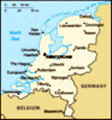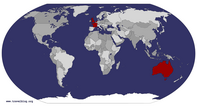Advertisement
Published: July 16th 2010
I woke up, stayed in bed, fell asleep again and woke up again. Then I got up and lounged around in the living room for a while until everyone else woke up. Once they had, we had breakfast together, me having two large bowls of cereal. There was several other items of food, but I didn't eat any. We packed up our things for the day and went and got in the car with Aunty Betsy.
Aunty Betsy drove us to a nearby town of Staphorst. There were several farms on the way, with different types of crop, but when we did get to Staphorst, we noted the unusual layout of the town. Instead of rows and rows of streets like a normal town, it has one road, then a house with 2 or 3 houses behind it. Aunty Betsy said that it was because the farmer had a house, then instead of giving the house to his eldest son, he would make another one behind it. And then he would build his eldest son another house behind is, and so on. Now though, the houses were owned by separate families. There were relatives who lived in Staphorst, one of
Aunty Betsy's children, Johan, and his wife, Marianna and children, Jan-Danie and Elma. We were greeted at the door and said hello and were invited to come out the back. There, we met the children, sat down around the table, and talked. Dad hadn't seen his cousin in 25 years since he last went to Holland.
Johan took Dad and I through the hedge behind their backyard to the soccer pitch, where we had a talk, before heading back for a drink. Marianna had got out the children's school reports, and they were both doing very well. We sat down, drank our drinks, and then, we were presented with a plate of desserts, which was some massive vanilla slices with orange icing. It was explained to us that because of Holland and the world cup, everything being sold in the bakery was orange. I sat down and ate a slice, and we kept talking, as you do if you haven't seen eachother in 25 years.
Once we had finished, we cleaned up and got into the car and drove the short distance through the town of Staphorst to a farmhouse museum. Not everyone came, it was just Dad,
Nana, Johan, Aunty Betsy and me. Entry was cheap, as it wasn't a massive museum, so we walked in and made our way through what was a typical Staphorst farmhouse, with alot explaining the traditional clothing. Staphorst is one of the few towns in Holland which still uses the traditional clothing, and most of the shops in the town are not open on Sundays because of it. The traditonal clothing is hard to describe, so you would have to look in the photos to get an understanding of it. When the women are young, they have to wear bright coloured clothing with red and green, then as the people around them die, such as their parents, their husband, etc, their clothes have to get darker and darker until they are completely black, symbolising complete mourning.
We wandered through the museum for a while, Johan explaing everything to us because it was all written in Dutch. It was an interesting museum, but there wasn't that much to see, so we left and drove a short way out of town towards a farm. This was the farm of one of Johan's friends, and when we arrived, we were greeted by a
man named Bart. Marianna and the children were already there, but stayed inside to talk with Bart's wife. We were shown around the farm, starting with the shed. The majority of the shed was for the cows when it was winter and they had to be inside, but in the corner was the milking area where the cows are milked, so we had a small look in there. First was the milk tank where all the milk was stored and collected twice a week. Then in the next room was the actuall milking room. In the middle was a dug out area, where the farmer stands to attatch the cups to the teats of the cows. It wasn't in operation, but it was still intersting. Bart talked to us, with Johan translating for us, and Dad asked questions about the farm.
We walked back into the main area, where we saw a day old calf, separated from its mother and trying to stand up, with little success. It was a little sad because the calf had to be separated, because otherwise there would be no milk given by the mother. Dad said it would either be sold, handraised or
killed. We walked outside to where the cows were eating in the field. It was a small field with 50 or 60 cows in it surrounded by canals. To the side, and fenced off were calves in what were called 'igloos,' where they can stay dry, be warm, be fed and grow up. We talked for a while longer, getting an understanding of the ways of farming in Holland, and how different they are to Australia.
We were called back to the house, where we were greeted by Bart's wife and her mother. She was wearing the traditional clothes, but all black because she was in mouring. They seemed very happy to see us, but it was hard to say hello because they only spoke Dutch and we only spoke English. We were shown the house, and it was a double house, so the grandmother lived in one side and Bart and his wife lived in the other. I had a glass of water, and listened to the conversation but it was hard because most of it was in Dutch.
We said goodbye, to Bart and his family, and to Johan and Marianna and their children, before getting
into Aunty Betsy's car and driving back towards Nunspeet, where we pulled into a restraunt by the train station and sat down. It was a pancake restraunt, and we got our orders for drinks and sat down and waited. After a very short while, Jan Willem joined us and then Johan's brother Henk came along. We sat down and ordered our meal, finding it much easier to understand the toppings on the pancakes than we had before. I ordered mine with salami, cheese and tomato. We sat down and talked, once again, Dad had not seen Henk in 25 years and I had never met him before. Our pancakes arrived and we dug in, enjoying every last bit of it. It took a while to finish, but when we did, Henk wanted a second one, and after much debate, he got it, and ate it quickly. We said goodbye to Aunty Betsy and Jan Willem, because Dad and I were going with Henk for the remainder of the afternoon. But we had to stop over at Aunty Betsy's house to pick up our bathers.
Henk drove us out and into the poulder, where he lived and worked. All of
the roads were flat and straight, because they didn't need to be curved because there was no reason. It made it tiring though. Henk pulled into his workplace and swiped his keycard to open the gate. Henk worked in an Experimental farm, where he studied milking cows and their habits and ways to produce the milk faster and more efficiently with better quality and cheaper. We had to wear overalls and boots, and we walked through and entered a massive shed, with heaps of smells and cows mooing. To our left was a darkened shed, and to our right was light. We walked through both sides spending about an hour there. Each side of the shed was divided into different sections, which I assumed had different types of milking or different feed, all to see which produced the best milk.
We walked through the shed, and there were different technologies involved with the cows. There was an automatic feeder where cows had special collars and it would reject a cow if it was eating too much and regulate how much a cow has to eat and what kind of grain the cow needs to eat. Alternatively, there was just
grain and hay put out infront of the cow and they could eat as much as they liked. There was always two alternatives. Some cows had a special back scratcher, others did not. There were different types of floor sweepers used for the cows, and there was different lighting and so on. We also got to have a look at a special milking robot, where the cows would come in, the machine would find the teats, extract the milk, detach and let the cow walk off again. Sometimes it would reject the cow because it was too soon since it had had its last milking. Then there was the old style like we had seen at the previous farm.
The whole operation had 24 hour CCTV coverage, with special programmes to track each of the cow's movements around the farm. It was intersting, and amazing to see the different types of treating cows. We also had a look in the poppy fields and how they were havesting/seeding poppies, as well as the machinery that they were using. We got back into the car and drove off, going around and having a look at the main entrance, before heading off
to the town where Henk lived.
Henk told us to ignore his mess, and we went in and got changed into our bathers, had a small bite to eat and a drink, and headed out again. Henk took us to a lock where the ships and canal boats come in and go out. The museum was closed, so we could only look through the windows, and see how the lock and the bridge worked. From there, we drove out to the other side of the lake, where there was a small beach. There were many people there, so we made our way through them all and into the warm water. We swam around for a while, throwing a tennis ball to eachother, and finding musceles on the bottom. We had fun, and our swim lasted about 45 minutes. There were a couple of boats we had to watch out for, but we didn't hit any.
We got out, dried ourselves off, then headed off to a small cafe for dinner, as we would have made it back to Aunty Betsy's quite late. It was like a small fish and chip shop, but we all ate hamburgers. Henk then
wanted to show us his old tractor. So we went to a farmer friend of his, and he got the tractor out, an old red Volvo, and drove it around for a while. Then he showed us some of the big potato harvesting machinery and the rabbits that belonged to his farmer friend and his family. Then, it was the long drive back to Aunty Betsy's, where we followed the World Cup 3rd place match between Germany and Uruaguay. After that, we went to bed.
Advertisement
Tot: 0.071s; Tpl: 0.013s; cc: 8; qc: 52; dbt: 0.0407s; 1; m:domysql w:travelblog (10.17.0.13); sld: 1;
; mem: 1.2mb




















